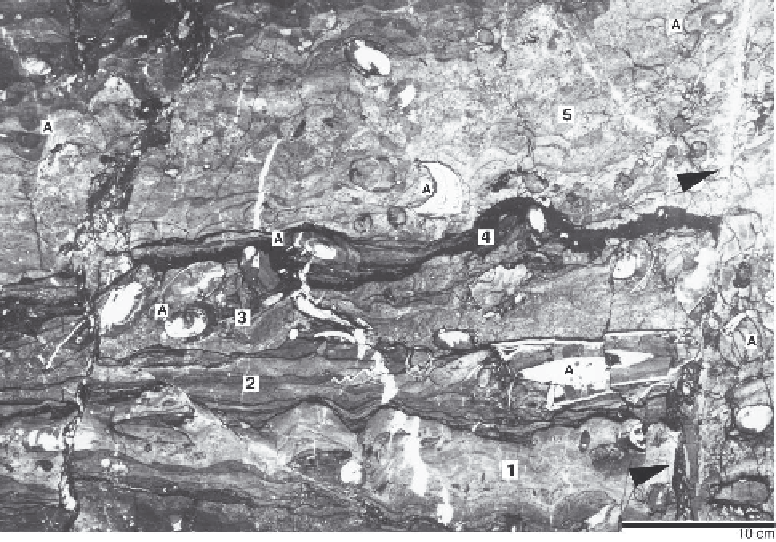Geology Reference
In-Depth Information
Fig. 15.38.
Strongly condensed pelagic cephalopod limestone.
The red limestone exhibits most of the criteria characteristic
of carbonates deposited in environments with strongly reduced or interrupted sedimentation: Stratigraphic condensation
indicated by the occurrence of guide fossils revealing a tremendous time range recorded by only very thin sedimentary units,
abundant hardgrounds and dissolution features, and internal brecciation and synsedimentary fissures. The sample comes
from limestones occurring in close proximity with radiolarites, and volcanics. The limestone, a bioclastic wackestone with
ammonites, shell debris and radiolarians is characterized by irregular layers of different thickness, separated by dissolution
surfaces, and abundant Fe-Mn crusts. The primarily aragonitic shells of the ammonites (A) are extremely dissolved and filled
with sediment or sparry calcite. Geopetal fabrics in the shells indicate reworking and redeposition. The lower part of the
picture (1) shows a transition from dark thin-layered to light, domed parts. The latter are characterized by sparry calcite
between dissolution clasts. Part 2 demonstrates the strong differences in the thickness of the irregular layers, caused by
sedimentary differences in the content of non-carbonate constituents. Part 3 is an example of internal brecciation. Part 4
shows a thick Fe-Mn crust characterizing the top of a hardground. Millimeter- to centimeter-thick Mn-Fe crusts also occur on
ammonite shells. Part 5 includes several relicts of dissolved ammonite shells. The nodular fabric reflects the strong dissolu-
tion of the pelmicritic sediment. The arrow points to the boundary of a vertical fissure ('neptunian dike', see Sect. 5.3.1)
filled with dissolution relicts and ammonites. These fissures have been explained by the effect of initial rifting. Note the
difference between this synsedimentary fissure and the tectonic fracture at the left of the picture. Early Middle Triassic:
Asklepeeion in Epidaurus, Argolis, central Greece. After Dürkoop et al. (1986).
sures are filled by alternating white sparry calcite
and red or green cryptocrystalline limestone. The
matrix-rich breccias above serpentinites have been
interpreted as magmatic carbonatites. Isotope data
point to a sedimentary origin.
The example shown in Fig. 15.38 fits some of the
criteria of pelagic carbonates potentially deposited at
or near the oceanic basement (association with vol-
canics, radiolarites). On the other hand, strong strati-
graphic condensation, the abundance of hardgrounds
and of ammonites conforms to deep-marine limestones
similar to those of the Hallstatt facies of the Alps formed
in relatively shallow deep-water basins.
•
Umbers: Brown iron-rich mudstones overlying mud-
stone (e.g. in Cyprus). Interpreted as products of pre-
cipitation from the interaction of magmatism and
seawater.
•
Radiolarites. Pillow lavas, as the uppermost part of
ophiolite sections, are generally overlain by bedded
radiolarites formed in a deep ocean below the cal-
cite compensation depth.
15.8.3 Contourites
Contourites are deep-water drifts (more than 2000 m
semipermanent bottom currents along the continents),
mid-water drifts (300-2000 m on continental slopes),
and outer shelf/upper slope drifts (50-300 m, formed
under the influence of countercurrents and underflows).
•
White nannofossil limestones typically overlie Ju-
rassic radiolarites. Lithologically indistinguishable
from Majolica, their continental counterpart.
•
Black shales.

